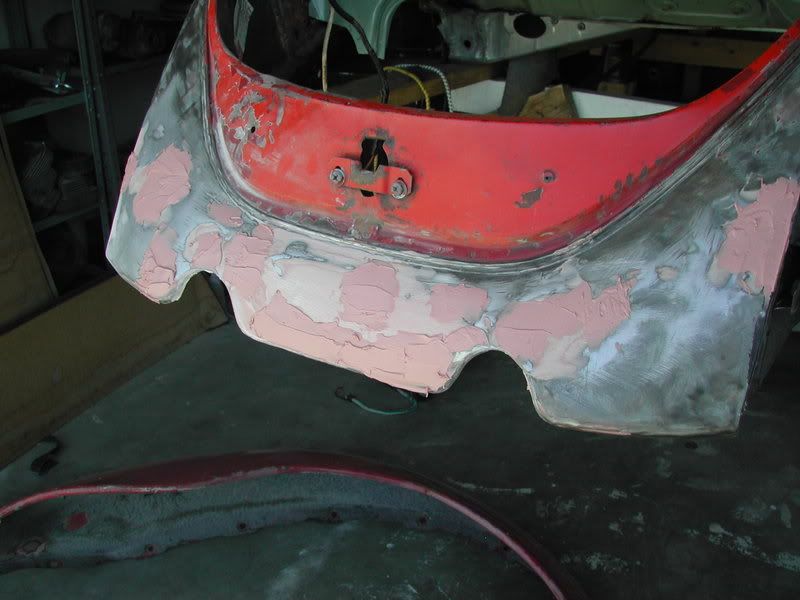I Know Why They Sell Bondo In Gallons- Breakthrough
-
saggs
- Posts: 216
- Joined: Thu Jan 25, 2007 11:47 am
I Know Why They Sell Bondo In Gallons- Breakthrough
I had a bodyworking friend stop by and give me a few pointers regarding body work on my 56 beetle. Boy, what a breakthrough! I had spent hours dollying and hammering and filling and sanding and filling again. Usually I did small low spots here and there and it took forever.  So this time I was trying to smooth out my front fenders and layed the Evercoat Rage on thick and covered a large area (on the outer edge-side). I then took a "cheese grater" and chewed down the high spots then used a long board w/ 80 grit to block it right down. The filler is much easier to sand if you don't let it sit more than 30-45 minutes. I accomplished in 45 minutes what had taken me hrs and hrs before.
So this time I was trying to smooth out my front fenders and layed the Evercoat Rage on thick and covered a large area (on the outer edge-side). I then took a "cheese grater" and chewed down the high spots then used a long board w/ 80 grit to block it right down. The filler is much easier to sand if you don't let it sit more than 30-45 minutes. I accomplished in 45 minutes what had taken me hrs and hrs before.  I am psyched to get the rest done now. By the way the bondo I'm putting on is now no more than 1/8" thick, it was just that the metal was so inconsistent. Good Luck.
I am psyched to get the rest done now. By the way the bondo I'm putting on is now no more than 1/8" thick, it was just that the metal was so inconsistent. Good Luck.
-
crvc
- Posts: 1564
- Joined: Fri Aug 29, 2003 2:37 pm
Years ago I did a ground-up restoration of a 1971 Porsche 914. That model used the same engine as the VW squareback. It had original paint. When I got around to stripping it, I found a lot of bondo under the paint. Never more than a few millimeters thick, but it in many places. So even Porsche would use a bondo-type product.
kevin
kevin
-
crvc
- Posts: 1564
- Joined: Fri Aug 29, 2003 2:37 pm

I forgot to add this to the previous post. When I bought this bug the rear had been crushed and repaired with a heavy slab of bondo two to three inches thick. It had been hit again and the slab sort of cracked and half peeled off.
Beneath this part there is a brace. After grinding all the old bondo off I removed the brace so I could bang the metal back toward normal shape. When it was as close as I could get it, I welded the brace back in place and started with fresh bondo. Maybe the photo doesn't show it, but nowhere is it more than two millimeters thick.
And bugfuel is right. I had a thick layer of bondo dust on the garage floor before I was done.
kevin
- ubercrap
- Posts: 1394
- Joined: Sun Apr 18, 2004 8:00 pm
-
crvc
- Posts: 1564
- Joined: Fri Aug 29, 2003 2:37 pm
I'd heard the term 'squareback' was commonly used for the 412 because it had a square back like a station wagon. The 411 was termed 'slantback' or fastback. But they both used the Porsche 914 D-jetronic fuel injected engine from 1970 to 1975. I junked my 412 squareback and saved the motor, using it to enlarge my 1970 914 from 1700cc to 2000cc. It was a simple exchange using Porsche 2000cc jugs with heads from the squareback. I saved the jugs and heads from the 914 to use in the 1967 VW project.
kevin
kevin
- tuna
- Posts: 2531
- Joined: Fri Apr 14, 2000 12:01 am
Actually, the 411 and the 412 were both available in three different body styles:ubercrap wrote:The 914 used the engine that debuted in the 411- originally only available in two or four door sedan- so I'm not sure why you are saying "squareback", but it isn't accurate.
- --> 2-door fastback sedan
--> 4-door fastback sedan
--> 2-door squareback station wagon
Tuna
http://vdubgeek.blogspot.com/
Type 4: Secrets Revealed - https://type4secrets.blogspot.com/
Tom's Type 4 Corner - coming soon!
EMPI Imp Homepage - coming soon!
My VWs - http://vdubgeek.blogspot.com/p/my-vdubs_5.html
Type 4: Secrets Revealed - https://type4secrets.blogspot.com/
Tom's Type 4 Corner - coming soon!
EMPI Imp Homepage - coming soon!
My VWs - http://vdubgeek.blogspot.com/p/my-vdubs_5.html
- ubercrap
- Posts: 1394
- Joined: Sun Apr 18, 2004 8:00 pm
I could be wrong, but I do believe that in the '69 model year (not officially sold in the U.S. of course), there were only 2 and 4 door "fastback" sedans available. But, yes, I was nitpicking I guess.tuna wrote:Actually, the 411 and the 412 were both available in three different body styles:ubercrap wrote:The 914 used the engine that debuted in the 411- originally only available in two or four door sedan- so I'm not sure why you are saying "squareback", but it isn't accurate.
He referred to it as a 'squareback', which is partially true. The confusion is that the Type 3 Squareback is what people think of when they say 'squareback', not it's bigger sister Type 4.
- --> 2-door fastback sedan
--> 4-door fastback sedan
--> 2-door squareback station wagon
Tuna